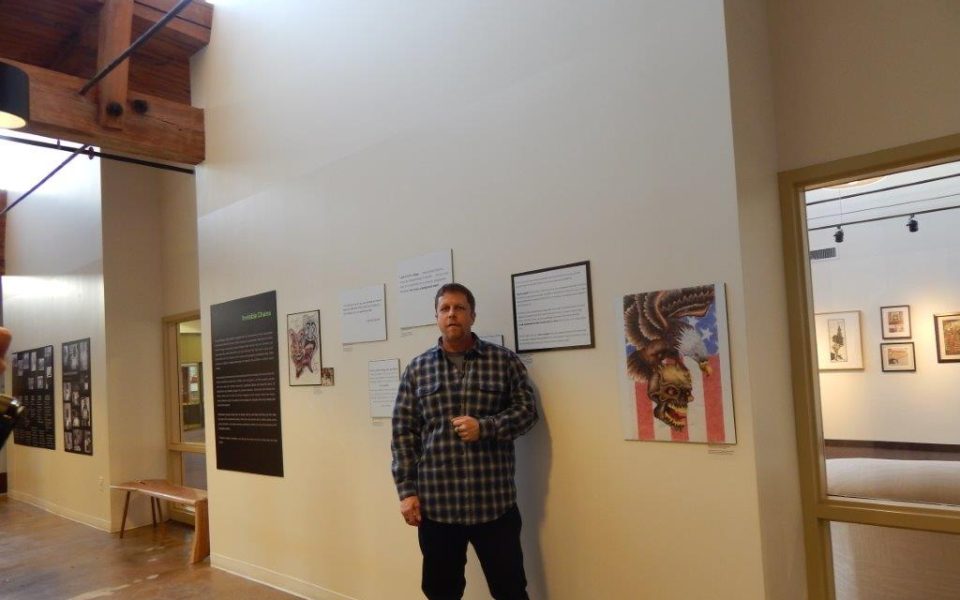by Sayaka Matsuoka
People don’t like talking about them. Society ignores them and often times they are treated like eyesores or awkward topics of conversation at best.
Release: From Stigma to Acceptance, an exhibit at the Sawtooth Center for Visual Arts offers a place for former offenders to open up about their experiences inside prison and in a sense, belong again.
The experience of re-entering society can be a harsh and immobilizing one for offenders laden with doubts about reconnecting with family, finding work or just keeping out of prison. But the biggest, most stunting problem that former inmates tackle out of prison is the almost immediate judgment that occurs when people learn that they were once locked up.
The collaborative exhibit between Winston-Salem’s Project Re-Entry program and students in a Wake Forest University public history class offered six formerly incarcerated men from Project Re-Entry the opportunity to demonstrate their value to society. One participant, Earl Dominie Jr., said in an online comment on the exhibition website that the show allows “folks like me to have a voice and a second chance to prove that we can make good choices to be the people we were meant to be.”
While locked up behind concrete walls, these men took the time to reflect on their lives and expressed hopes and fears, which now adorn a different set of concrete walls. The exhibit posted in a Sawtooth hallway outlines their experiences through their own drawings, poems, songs and stories.
Two themes are woven throughout the show: invisible chains and support systems. Dominie’s drawing “Laugh Now, Cry Later” visualizes the former. The phrase, a common one in prison, is represented in His intricate and colorful drawing of two exaggerated faces, one depicting laughter and the other pain. It showcases the physical and mental struggles that often define life in incarceration. Many of Dominie’s other works also play with the duality of good and evil, like his pencil drawing of a wicked skull with razor teeth suddenly split by a delicate rose, or his patriotic drawing of a valiant eagle clutching a burning skull in its talons.
Other, less metaphorical works in the exhibition touch on the theme of support systems like Steven McBride’s “The Last Letter.” McBride wrote the song as a farewell to his wife, who passed away during his time in jail. The song is simple but sentimental, with lines like, “I think of all the things I’d like to say, if only I could see your face,” accompanied by chords scribbled underneath. Ron Hartzler’s predictable but moving “A Daddy’s Love for His Daughter” addresses similar issues with emotional stanzas professing his undying, everlasting love for his daughter.
The goal of the show is for viewers to release their preconceived notions about former offenders. Perhaps the most moving part isn’t the works by the inmates but the quotes by the Wake Forest students recounting their initial experiences at the prison, where they met the participants for the first time. Although some express their fears and inhibitions about meeting what many would consider “dangerous criminals,” all of the quotes describe a sort of melting or fading away of those fears shortly after meeting the men.
“How could it be that within a few minutes of talking with supposedly ‘dangerous’ deviants, my body had collapsed into a state of calm?” one student asked.
The opening paragraph of the exhibition begs the question of what a criminal looks like. What race or gender they are. What they wear. By the end, viewers are hit with the striking reality that these men are humans with personalities and aspirations just like anyone else. They aren’t just wasted space, or people to be ignored, or hidden and kept out of sight. The six men re-entering the outside world don’t let the experience of prison define them, and all they ask is for society to do the same.
Join the First Amendment Society, a membership that goes directly to funding TCB‘s newsroom.
We believe that reporting can save the world.
The TCB First Amendment Society recognizes the vital role of a free, unfettered press with a bundling of local experiences designed to build community, and unique engagements with our newsroom that will help you understand, and shape, local journalism’s critical role in uplifting the people in our cities.
All revenue goes directly into the newsroom as reporters’ salaries and freelance commissions.




Leave a Reply